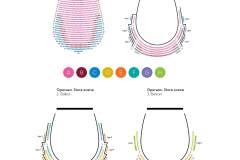The Barber of Seville
Mo | Tu | We | Th | Fr | Sa | Su |
An electrifying cinematic adaptation of Rossini's classic about a quick-witted barber.
The Barber of Seville is performed in Italian with Danish and English supertitles.
Recommended for ages 8 and up.
Expected duration: 2 hours and 45 minutes incl. 1 interval
Reumert Award-winning director Martin Lyngbo has masterfully orchestrated a critically acclaimed interpretation of Rossini's comedic opera The Barber of Seville, inspired by silent movies. This rendition serves as an ideal entry point for anyone embarking on their opera journey.
The tale of the cunning Figaro serves as a precursor to Mozart’s equally comedic and whimsical plot in Le nozze di Figaro. In Rossini's opera, the shrewd barber has not yet met his future beloved, Susanna. Instead, he assists his lovestruck friend, Count Almaviva, in liberating the coveted Rosina from the clutches of her avaricious guardian, Don Bartolo.
Martin Lyngbo’s fast-paced slapstick staging highlights the light and cheerful story along with Rossini’s catchy music. The Barber of Seville received outstanding reviews at its premiere in 2018. The press notably mentioned that: “The idea of translating Rossini’s comedic opera The Barber of Seville into a silent film is close to genius.”
Theodore Platt from the Royal Danish Opera's soloist ensemble and Dean Murphy alternate in the title role, while the renowned Rossini tenor Sunnyboy Dladla and the critically acclaimed Liam Bonthrone take turns performing as Count Almaviva.
This exhilarating, whirlwind rendition of The Barber of Seville is musically and visually entertaining for new operagoers as well as seasoned opera buffs who appreciate classics in new guises.
Synopsis
Act I
Figaro, a vagabond, wakes up after having spent the night in the cellar be - neath a barbershop. The prospect of having his own barbershop sends Figaro daydreaming, and as he meets a former employer, Count Almaviva, Figaro pretends to be a sought-after barber.
Count Almaviva is pursuing a young woman, Rosina, who lives in the house next to the barbershop. He hires Figaro, always eager for a paid job to help him woo the girl. Orphaned Rosina lives under the authority of the wealthy Doctor Bartolo who plans to marry her, much to the chagrin of the young woman. Plans must be made in order to cheat Bartolo.
Berta, Bartolo’s housekeeper, is in love with Bartolo and is having an affair with him. While the two are engaged in a dalliance in Berta’s room, Almaviva furtively makes advances to Rosina, presenting himself as Lindoro, a poor student, in the hope that Rosina will fall in love with his person rather than his title and wealth. Rosina is increasingly charmed by the young man, but Basilio, a goon and music teacher employed by Bartolo, interrupts the flirtation. Almost exposed as an imposter by the real barber, Figaro manages to hit the barber over the head, making him pass out. Rosina writes a letter to Lindoro.
Figaro overhears a conversation bet - ween Basilio and Bartolo: Basilio has found out that Count Almaviva is pursuing Rosina and suggests that Bartolo rids himself of his rival by spreading gossip about the count, but Bartolo prefers to expediate his wedding plans. Bartolo og Basilio head to the notary’s for a marriage contract. Figaro visits Rosina, warning her of Bartolo’s schemes and receiving her letter for Lindoro. Figaro, too, falls in love with Rosina, but duty compels him to remain faithful to his assignment for Count Almaviva.
Almaviva, having been disguised as a drunken soldier by Figaro, shows up at Doctor Bartolo’s demanding to be quartered. Bartolo refuses and a brawl ensues during which Lindoro manages to slip a love note to Rosina.
Act II
Figaro disguises Almaviva again, this time as a music teacher, and the count knocks on Bartolo’s door, claiming that his name is Don Alonso, that Basilio has taken ill and that he himself will be undertaking today’s music lesson as his substitute. He wins Bartolo’s confidence by showing him Rosina’s note to Lindoro, which he claims to have intercepted. Bartolo lets him in for a music lesson with Rosina. Meanwhile Figaro, still disguised as the barber, must tinker his way through a clumsy shaving of Bartolo as well as an awkward tattoo session with Basilio. He fails, however, to distract Bartolo from overhearing Almaviva and Rosina plotting their elopement. Furious, Bartolo attemps to catch the count and Figaro, who manage to escape.
Bartolo tells Rosina that her dear Lindoro is merely a flunky of Count Almaviva who intends to give her over to the count as his mistress. He offers her own note to Lindoro, given to him by Don Alonso, as proof, and Rosina loses all hope. Berta, too, is devastated, realizing that Bartolo means to marry his young ward. The real barber wakes up, only to be attacked by Basilio who mistakes him for Figaro and is intent on making him pay for having botched his tattoo.
Figaro and Almaviva return to Rosina, who furiously throws at them the accusations made by Bartolo about their supposed collusion with Count Almaviva. Almaviva reveals that Lindoro and the count are one and the same and wins over Rosina. Having only eyes for each other, Rosina and Almaviva fail to heed Figaro’s warnings that Bartolo is on his way.
With no time left to escape unseen, the young couple decide instead to get married on the spot. They summon the notary and threaten Basilio to be their witness. Bartolo arrives only to find that the marriage contract has already been signed. As Bartolo admits defeat, the greedy Basilio decides to plunder Basilio’s luxurious home. Berta watches him, enthralled by Basilio’s new-found wealth and resolves to force him at gunpoint to marry her. Figaro is paid for his service by Almaviva, but as the real barber shows up he is forced to give up his money to the barber by way of compensation for his pain and suffering. Figaro the vagabond is left empty-handed outside the barbershop – no richer than when he woke up that same morning.
Program and cast
Conductor: Matteo Beltrami
Conductor: Nick Fletcher
Director: Martin Lyngbo
Revival Director: Line Kromann
Scenograf og kostumedesigner: Rikke Juellund
Choreographer: Kristjan Ingimarsson
Light Designer: Ulrik Gad
Dramaturge: Henrik Engelbrecht
Cast - Subject to change
Conductor: Matteo Beltrami
Conductor: Nick Fletcher
Count Almaviva: Sunnyboy Dladla
Count Almaviva: Liam Bonthrone
Doctor Bartolo: Morten Staugaard
Doctor Bartolo: Tiziano Bracci
Rosina: Patricia Nolz
Rosina: Valerie Eickhoff
Figaro: Theodore Platt
Figaro: Dean Murphy
Basilio: Kyungil Ko
Basilio: Henning von Schulman
Berta: Frederikke Kampmann
Notary/Officer: Frederik Rolin
Notary/Officer: Magnus Berg
The Copenhagen Opera House
The house is administered by the Royal Danish Theatre and is one of the best-equipped in the world. It has a main stage with five other stages directly connected, where large setups can be moved easily in and out. The theatre can seat between 1492 and 1703, depending on the size of the orchestra. The 1492 seats are all individually angled in order to provide the best experience.
The orchestra pit is one of the largest in any opera house, with room for 110 musicians; the structure provides excellent sound quality for the orchestra. If the pit is filled, some musicians are located just below the front of the stage, which has become controversial among some members of the orchestra (according to tour guides in 2005), because this increases the sound levels, beyond those acceptable in Denmark. However, the overhang is very slight and the authorities have permitted this to happen.
During construction of the theatre, some acoustic tests were carried out with the fire curtain in place while technical work was carried out on stage, but great consideration was given to balance between pit and stage. If the orchestra is small or absent, the pit can be covered and additional seats can be added to the auditorium.
Opera House entrance
Just like the old Royal Danish Theatre in Copenhagen, The Queen has her own box on the left side of the auditorium, closest to the stage. The foyer has been designed for comfort, based on behavioural research on opera goers maximizing the wall area for standing against, while still providing views across the entire foyer and one of the best views on Copenhagen. Guided tours cover most of the building, including both the auditorium and backstage areas.

 EN
EN DE
DE IT
IT FR
FR ES
ES RU
RU JP
JP RO
RO
 Seating plan
Seating plan 
